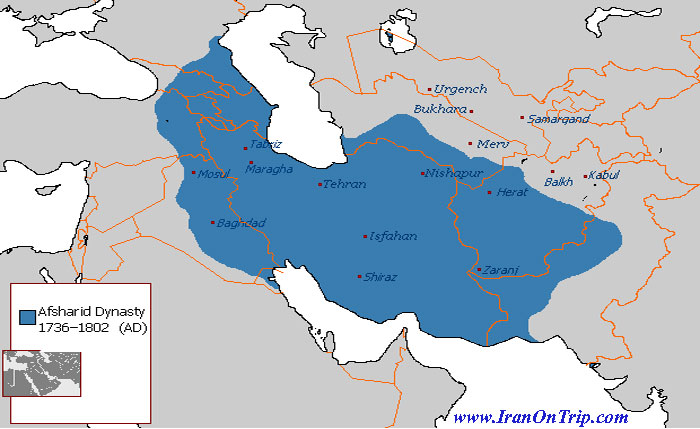Afsharid dynasty

The Afsharids (Persian: افشاریان) were members of an Iranian dynasty of Turkic origin, specifically the Afshar tribe, from Khorasan, who ruled Persia in the 18th century. The dynasty was founded in 1736 by the military commander Nader Shah, who deposed the last member of the Safavid dynasty and proclaimed himself King of Iran. During Nader's reign, Iran reached its greatest extent since the Sassanid Empire. After his death, most of his empire was divided between the Zand and the Durranis, and Afsharid rule was confined to a small local state in Khorasan. Finally, the Afsharid dynasty was overthrown by Mohammad Khan Qajar in 1796.
The dynasty was named after the Turkic Afshar tribe to which Nader belonged. The Afshars had migrated from Turkestan to Azerbaijan in the 13th century. In the early 17th century, Shah Abbas the Great moved many Afshars from Azerbaijan to Khorasan to defend the north-eastern borders of his state against the Uzbeks. Nader belonged to the Qereqlu branch of the Afshars.
Foundation of the dynasty

Nader Shah was born (as Nader Qoli) into a humble semi-nomadic family of an Afshar tribe of Khorasan, where he became a local warlord. His path to power began when the Ghilzai Shah Mahmud overthrew the weak Safavid shah Sultan Husayn in 1722. At the same time, Ottoman and Russian forces seized Persian land. Nader joined forces with Sultan Husayn's son Tahmasp II and led the resistance against the Ghilzai Afghans, driving their leader Ashraf Khan out of the capital in 1729 and establishing Tahmasp on the throne. Nader fought to regain the lands lost to the Ottomans and restore Persian control of the Afghans. While he was away in the east fighting the Ghilzais, Tahmasp allowed the Ottomans to retake territory in the west. Nader, disgusted, had Tahmasp deposed in favour of his baby son Abbas III in 1732. Four years later, after he had recaptured most of the lost Persian lands, Nader was confident enough to have himself proclaimed shah in his own right at a ceremony on the Moghan Plain.
Nader's conquests and the succession problem
Nader initiated a new religious policy aimed at reconciling Shia with Sunni Islam. The Safavid dynasty had relied heavily on the support of Shi'ites, but many soldiers in Nader's army were Sunnis. Nader also wanted to set himself up as a rival of the Ottoman sultan for supremacy within the Muslim world, which would have been impossible had he remained an orthodox Shi'ite.Soon afterwards Nader waged a war against the Afghans and captured Kandahar. In 1738, he invaded Mughal India, massacred 30,000 of the inhabitants of Delhi and in a single campaign captured an incredible amount of wealth, including the legendary Peacock Throne and the Koh-i-Nor diamond.After his return from India, Nader fell out with his eldest son Reza Qoli Mirza, who had ruled Persia during his father's absence. Having heard a rumour that Nader was dead, he had prepared to seize the throne by having the Safavid royal captives, Tahmasp and his son Abbas, executed. Nader was not pleased with the young man's behaviour and humiliated him by removing him from the post of viceroy. Nader became increasingly despotic, taxing his subjects heavily to pay for his military campaigns, and his health decayed. When there was an assassination attempt on him during an expedition to Daghestan, Nader blamed Reza and in 1742 had him blinded so he could not succeed to the throne Nader's despotism and excessive demands for tax provoked many revolts. In 1747 while on his way to crush one of them, he was assassinated by two of his own officers. Iran was soon to descend into civil war.
Civil war and downfall of the Afsharids
After Nader's death, his nephew Ali Qoli (who may have been involved in the assassination plot) seized the throne and proclaimed himself Adil Shah ("The Just Shah"). He ordered the execution of all Nader's sons and grandsons, with the exception of the 13-year old Shahrokh, the son of Reza Qoli. Meanwhile, Nadir's former treasurer, Ahmad Shah Abdali, had declared his independence by founding the Durrani Empire in Khorasan. In the process, the eastern territories were lost and in the following decades became part of Afghanistan, the successor-state to the Durrani Empire.Adil made the mistake of sending his brother Ebrahim to secure the capital Isfahan. Ebrahim decided to set himself up as a rival, defeated Adil in battle, blinded him and took the throne. Adil had reigned for less than a year. Meanwhile a group of army officers freed Shahrokh from prison in Mashhad and proclaimed him shah in October 1748. Ebrahim was defeated and died in captivity in 1750 and Adil was also put to death at the request of Nader Shah's widow. Shahrokh was briefly deposed in favour of another puppet ruler Soleyman II but, although blinded, Shahrokh was restored to the throne by his supporters. He reigned in Mashhad and from the 1750s his territory was mostly confined to Khorasan. In 1796 Mohammad Khan Qajar, the founder of the Qajar dynasty, seized Mashhad and tortured Shahrokh to force him to reveal the whereabouts of Nader Shah's treasures. Shahrokh died of his injuries soon after and with him the Afsharid dynasty came to an end. Shahrokh's descendants continue into the 21st century
.....
.....
.....

.jpg)



























